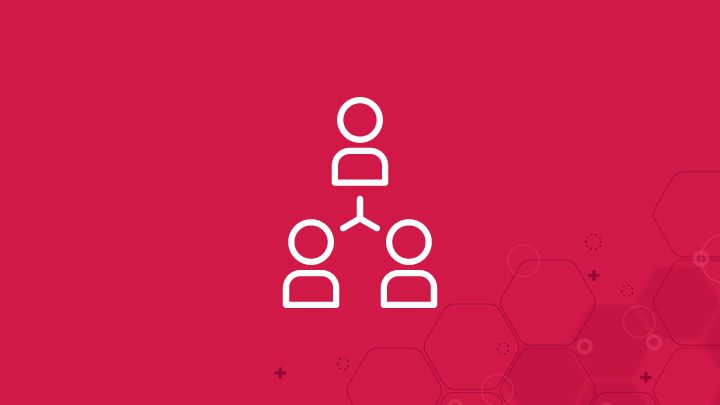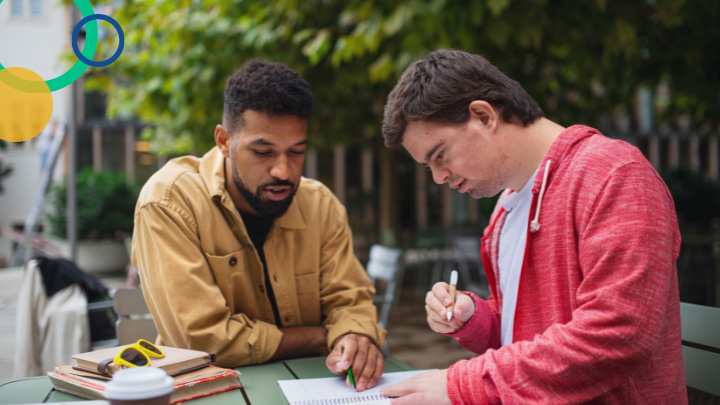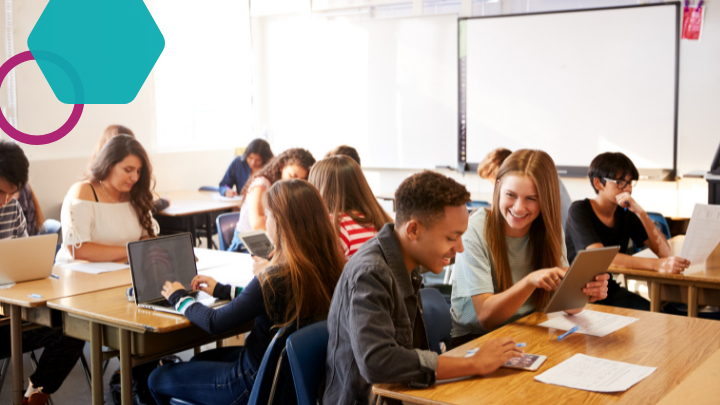In the world of teaching that can be overwhelming, find happiness in the fact that great improvement can be derived from taking the time to form a bond with students.
In the first of a two-part blog, BetterLesson 7th grade Science Master Teacher and 2017 MSTA Middle School Science Teacher of the Year, Leigh Ann Roehm shares her journey as a teacher of students with diverse learning styles and students with special needs sharing key teaching moves and strategies to strength-based teaching.
At the end of another teaching day, I made my way through hallways of noisy students headed to a staff meeting. On my way I noticed that I had received a voicemail from my younger brother, Andre, but it would have to wait. In the meeting, administration led the staff through a self-discovery activity. On the handout I saw the word “Me” at the center of a web. My task was to write eight words in the web that represented me.
I knew immediately one descriptor I would share, “Sister of Andre.” Prior to his birth, my brother Andre had a stroke. He was born with cognitive deficiencies, physical disabilities, and behavioral struggles that would affect his entire life. I grew up watching my parents advocate for his education. I watched as incredible educators shaped his life and welcomed Andre and was saddened as I observed some educators struggle to help Andre become an active member of the classroom. From these experiences, I felt a calling to become an educator. I wanted to help all students learn.
I left the staff meeting that day and got in my car, still wondering, “Who am I as an educator?” I played the voicemail Andre had left me earlier that day. Hearing his voice I quickly realized that Andre’s voicemail was him singing me a song. My 30 year-old brother, still at the developmental level of a 5 year-old, sang clearly and confidently.
When you look at me, I hope that you will see, Not just the things I can't do, Sometimes it's hard to see.
I cried. It dawned on me that I had a new descriptor of who I am as an educator. Andre had taught me that I am a builder of relationships.
This video is a compilation of pictures of my brother with my daughters set to the voicemail Andre left me on that day. The words of Andre’s song were so inspiring to the educator side of me.
Reaching all students is a challenging task for any educator. All students enter our classrooms at a different place, with their individual strengths and struggles. When working with students that have disabilities, there is no one strategy, one resource, one educational program that can work for every child. Helping students with disabilities reach their academic success will always be an area that we as teachers are striving to improve.
Andre’s message to me as an educator was that students with disabilities “do the best they can everyday.” Therefore, it is vital as teachers to instill deliberate and intentional time for relationship building with the students. I need to see “not just the things (they) can’t do,” but also what they as unique individuals can “do”. While there will never be one way to reach all students, I can confidently say that at the heart of every success story I have had with students, is a meaningful relationship between the student and me. At the end of the day, teachers are builders of relationships.
Here are some strategies that can be utilized to build meaningful relationships:
Greetings and salutations
There is a profound power in the word “hello.” Find a way to show sincere joy when your students arrive. Whether it’s a fist bump, a high five, a secret handshake, or a simple “hi,” greetings and salutations go a long way to show your students you care. An example of a daily way to create these human interactions is in the BetterLesson Thresholding to Greet Students at the Door strategy.
Talk to your students
In the hustle and bustle of the teaching day, build in intentional time to sit and just talk to your students with disabilities. Even when you feel the pressure to get back to academics, feel confident that two minutes talking to a child about what they are interested in will produce larger dividends in productive, academic work than you may imagine. For example, I Wish My Teacher Knew is a strategy you could use to get to know your students better.
Model risk-taking and vulnerability
It is challenging for students to work outside their comfort zones. However, if they see that you are willing to take chances yourself, students believe they can do it too. I take time to talk about my failures. I share stories about my family. I explain the challenges I had when I was in school. I try new strategies in my classroom and let the students know that I could use their help in “tweaking” it if it doesn’t go well. Modeling risk taking and vulnerability builds trust. A great place to introduce and support students in taking risks is in a Class Meeting or Morning Meeting.
Set clear expectations.
For some students with disabilities, school is a mystical puzzle that can be very confusing. A huge piece to your relationship with your students stems from their confidence in knowing what they are supposed to learn. Taking time to communicate clear and attainable targets for students with disabilities allows them to set out on the journey of learning with you. Learning targets are a trust builder. Use and adapt the strategy Creating and Improving Class Rules and Procedures with Students to collaboratively develop your classroom’s clear behavioral and academic expectations.
Encourage failure
Students with disabilities benefit from seeing that failure is valued as a learning experience. I use the phrases “Learning is a Journey” and “Epic F.A.I.L.s” in my classroom to encourage this culture. We are all at a different place on our learning journey and it is our First Attempts In Learning that give us the feedback we need for success! You could explore teaching your students about Developing a Growth Mindset by exploring this strategy in the BetterLesson Lab.
Establish a specific praise and gratitude routine.
Scheduling intentional time for praise is crucial to building relationships. In order to hear your feedback, students need to trust that you see their successes as well. Consider creating one day a week that you send positive emails home highlighting specific examples of student success. In addition, when students check in with you about their work, start with something specific that the student was successful with in relationship to the learning target before providing feedback for improvement. For a student to value this praise, avoid simply giving generic praise such as “Good job!”. To build relationships, students appreciate that you saw the unique and specific strategies that they personally utilized. Have your students express and reflect as a class-wide social-emotional practice using the strategy Gratitude Sharing & Reflecting.
Be aware of your tone and body language.
Body language and tone convey a clear message to students. Students are very perceptive; they will feel frustration if they sense your own. To build a relationship founded on trust, I have found that students need to feel patience and understanding that is conveyed by your body language and tone. Students also value being able to share their emotions and hear your emotions and feelings. One way to support students to share their emotions and for you to share yours as well is to try an Emoji Wheel Connection (access this strategy with your BetterLesson account).
Own your own biases and perceptions.
Every teacher and student has bias. The key is to recognize when these are coming into play and impacting your instruction. Recognizing moments where you are making a judgement about a child’s disability or behavior is crucial for progress. Take a journey of self discovery using the strategy Identifying and Addressing Implicit Bias. Only then can you adjust your own behavior to promote meaningful relationships.
Forming connections with students is essential for the success of all students, not just students with disabilities. The students that enter our classrooms all have the ability to grow and learn. It is up to us to create intentional moments that allow us to see the inspiration they can provide.
Students need to see teachers as someone they can trust with their mistakes. They need to feel that I will see their greatness amidst their struggle. Teachers are builders of relationships.






